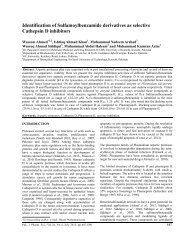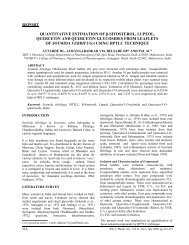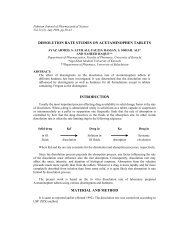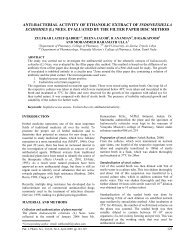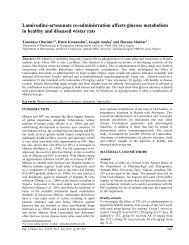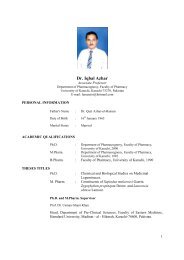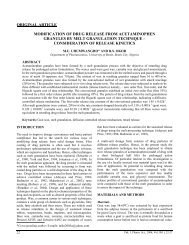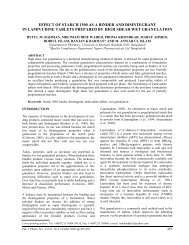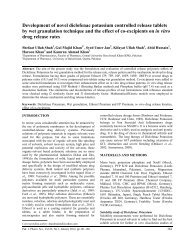In vitro tumor cytotoxic activities of extracts from three Liriodendron ...
In vitro tumor cytotoxic activities of extracts from three Liriodendron ...
In vitro tumor cytotoxic activities of extracts from three Liriodendron ...
Create successful ePaper yourself
Turn your PDF publications into a flip-book with our unique Google optimized e-Paper software.
<strong>In</strong> <strong>vitro</strong> <strong>tumor</strong> <strong>cytotoxic</strong> <strong>activities</strong> <strong>of</strong> <strong>extracts</strong><br />
<strong>from</strong> <strong>three</strong> <strong>Liriodendron</strong> plants<br />
Jin-Hui Chen 1 , Guo-Xu Yang 2 , Qiang Ding 3 , Tian-Song Xia 3 , Jisen Shi 1 and Ai-Qun Jia 2 *<br />
1 Key Laboratory <strong>of</strong> Forest Genetics and Biotechnology <strong>of</strong> the Ministry <strong>of</strong> Education <strong>of</strong> China,<br />
Nanjing Forestry University, Nanjing, China<br />
2 School <strong>of</strong> Environmental and Biological Engineering, Nanjing University <strong>of</strong> Science and Technology, Nanjing, China<br />
3 Department <strong>of</strong> Breast Surgery, the First Affiliated Hospital <strong>of</strong> Nanjing Medical University, Nanjing, China<br />
Abstract: The <strong>extracts</strong> prepared <strong>from</strong> <strong>Liriodendron</strong> tulipifera Linn., L. chinense (Hemsl.) Sarg., and their hybrid L.<br />
chinense x L. tulipifera, were investigated for their <strong>cytotoxic</strong> abilities in <strong>vitro</strong> against five human cancer cell lines: MDA-<br />
MB-231 and MCF-7 breast cancer cells, SGC-7901 gastric cancer cells, HuH-7 hepatocarcinoma cells, and HCT-15<br />
colon carcinoma cells, and then measured their phenols and alkaloids contents. Of these plant <strong>extracts</strong>, some <strong>of</strong> them,<br />
especially the lower polar <strong>extracts</strong> <strong>from</strong> barks, exhibited potent <strong>cytotoxic</strong> effects on five tested <strong>tumor</strong> cell lines.<br />
Keywords: <strong>Liriodendron</strong>; polyphenol; alkaloid; <strong>tumor</strong> cells; <strong>cytotoxic</strong> activity.<br />
INTRODUCTION<br />
<strong>Liriodendron</strong> is a genus in the Magnoliaceae family<br />
consisting <strong>of</strong> two species <strong>of</strong> large deciduous trees, one<br />
named L. tulipifera native to eastern <strong>of</strong> North America,<br />
and the other named L. chinense to South China. Both <strong>of</strong><br />
these two species showed diversity in medications in<br />
America, China, and other countries. L. tulipifera, known<br />
as the tulip tree or yellow poplar, is a majestic tree <strong>of</strong>ten<br />
reaching one hundred feet height, which is specific<br />
species in the eastern United States (Keeler, 1902). The<br />
bark <strong>of</strong> L. tulipifera had been used by the native<br />
Americans as a tonic, stimulant and febrifuge, and likely<br />
to treat the intermittent fevers related with malaria<br />
(Rafinesque et al., 1828). The historical use <strong>of</strong> L.<br />
tulipifera as an antimalarial remedy in the United States<br />
was supported deeply recently (Graziosea et al., 2011). It<br />
had also been used by the later native Americans as a<br />
suitable replacement <strong>of</strong> the imported and <strong>of</strong>ten scarce<br />
cinchona bark (Thacher, 1967). <strong>In</strong> <strong>In</strong>dia, L. tulipifera was<br />
also used to treat restorative, rheumatism, and dyspepsia<br />
(Kuanar, 2006). <strong>In</strong> China, the barks, leaves, and roots <strong>of</strong><br />
the sibling species L. chinense were used to treat<br />
rheumatism and cough due to wind-cold evil (named<br />
‘Feng Han’ in China) as traditional Chinese medicines<br />
(TCM) (Jiangsu New College <strong>of</strong> Medicine, 2001). <strong>In</strong><br />
1963, a new hybrid strain, L. chinense x L. tulipifera, was<br />
successfully cultivated by Pr<strong>of</strong>. Peizhong Ye. The great<br />
advances have been made no matter in the theory <strong>of</strong> forest<br />
tree genetics and breeding or the application in plantation<br />
and landscape (Wang, 2003). However, so far, the<br />
medicinal values <strong>of</strong> the hybrid tree have not been<br />
investigated yet.<br />
Cancer has caused millions <strong>of</strong> deaths each year worldwide.<br />
*Corresponding author: e-mail: jiaaiqun@gmail.com<br />
Pharmaceutical intervention with plant-derived products<br />
alone or in combination to reverse, suppress, or even<br />
prevent cancer plays a key role in the fight against this<br />
terrible disease (Siveen and Kuttan, 2010). There has been<br />
increasing interest in alternative medicine and nontoxic<br />
therapeutic approaches to anti-<strong>tumor</strong>al treatment. It has<br />
been reported that some natural components <strong>from</strong> the<br />
ethnobotany or diet are effective against cancer and are<br />
safe to the normal cells (Hakimuddin et al., 2006). To<br />
further investigate potential anti<strong>tumor</strong> bioactive<br />
components in TCM (Wu et al., 2010) or potential<br />
replaceable medicinal ethno-health-promoting plants, a<br />
screening <strong>of</strong> the crude <strong>extracts</strong> <strong>of</strong> two <strong>Liriodendron</strong><br />
species and the hybrid was assessed against five <strong>tumor</strong><br />
cell lines using the MTT (3-[4,5-dimethylthiazol-2-yl]-<br />
2,3-diphenyltetrazodium bromide) assay in <strong>vitro</strong>.<br />
MATERIALS AND METHODS<br />
Plant materials, chemicals and cell lines<br />
Fresh plant materials (leaves and barks ca 500 g<br />
respective) <strong>of</strong> each species were harvested in Nanjing<br />
Forestry University (NFU) in August, 2010. All collected<br />
specimens were identified systematically by Pr<strong>of</strong>. Jisen<br />
Shi, and voucher specimens <strong>of</strong> each plant species are<br />
deposited in herbaria at Nanjing University <strong>of</strong> Science<br />
and Technology (NUST) (voucher reference numbers are<br />
LT-001-B, LT-001-L, LC-001-B, LC-001-L, LX-001-B,<br />
and LX-001-L).<br />
Two chemicals to measure the total phenol contents as<br />
standards, gallic acid (GA), folin-phenol (2M), and <strong>three</strong><br />
<strong>cytotoxic</strong> assay reagents, MTT (3-[4,5-dimethylthiazol-2yl]-2,3-diphenyltetrazodium<br />
bromide), fluorouracil (5-Fu),<br />
and adriamycin, were purchased <strong>from</strong> Sigma, USA.<br />
Norisoboldine (NIB) as standard to measure alkaloid<br />
contents was purchased <strong>from</strong> Zelang Medical Technology<br />
Pak. J. Pharm. Sci., Vol.26, No.2, March 2013, pp.233-237 233
<strong>In</strong> <strong>vitro</strong> <strong>tumor</strong> <strong>cytotoxic</strong> <strong>activities</strong> <strong>of</strong> <strong>extracts</strong> <strong>from</strong> <strong>three</strong> <strong>Liriodendron</strong> plants<br />
Co. Ltd., Nanjing, China; five <strong>tumor</strong> cell lines, MDA-<br />
MB-231, MCF-7, SGC-7901, HuH7, and HCT15 were<br />
presented <strong>from</strong> the First Affiliated Hospital <strong>of</strong> Nanjing<br />
Medical University, Nanjing, China. All other chemicals<br />
were analytical reagents.<br />
Preparation <strong>of</strong> plant <strong>extracts</strong><br />
Freshly collected plant materials were separated to leaves<br />
and barks (as required) and immediately air dried in an<br />
oven at 35 o C. Dried materials (ca 350 g) were ground in a<br />
laboratory mill to a moderately fine powder (ca 40<br />
meshes).<br />
To investigate anti-<strong>tumor</strong> effects <strong>of</strong> <strong>three</strong> species<br />
systematically, two extract methods were used: The first<br />
was, to grind the air-dried barks <strong>of</strong> L. tulipifera to ca 40<br />
meshes, then extract with 95% EtOH (500 mL × 3). After<br />
removal <strong>of</strong> the solvent by evaporation in vacuo, the<br />
residues (ca 35.0 g) were obtained and re-dissolved in 500<br />
mL MeOH. The ethanol solution was filtrated, and the<br />
clear solution was subjected to evaporate under vacuum<br />
again. The final residue (30.4 g, LTB0 in table 1) was<br />
divided into two parts. 5.0 g was left for bioassay. The<br />
other 25.4 g was re-dissolved in 200 mL MeOH, and was<br />
mixed with 100-200 mesh silica gel, dried it in vacuo,<br />
eluted silica gel with MeOH, and then evaporated under<br />
reduced pressure. next, the extract eluted <strong>from</strong> silica gel<br />
was re-extracted with chlor<strong>of</strong>orm (250 mL × 3) and<br />
MeOH (250 mL × 3) successively to yield LTB1 (8.4 g)<br />
and LTB2 (13.3 g) finally; The second extract method<br />
was according to (Yan et al., 2009) with some<br />
modifications, the powdered bark <strong>of</strong> L. tulipifera was<br />
infiltrated with 10% ammonia over night, filtrated, then<br />
refluxed with chlor<strong>of</strong>orm (2 L× 3). The solution was<br />
filtrated again. The organic part was concentrated under<br />
reduced pressure to about 500 mL. The chlor<strong>of</strong>orm<br />
solution acidified with 1 M HCl solution until no alkaloid<br />
was detectable. The solution was adjusted to pH ≥ 9 with<br />
ammonia solution. Finally, the basic solution was<br />
extracted with chlor<strong>of</strong>orm (100 mL × 3) again, and<br />
evaporated chlor<strong>of</strong>orm in vacuo to obtain the dry residue<br />
1.34 g.<br />
Table 1: The yields <strong>of</strong> different <strong>extracts</strong> <strong>from</strong> different plant tissues<br />
234<br />
Other <strong>Liriodendron</strong> plant materials such as the barks <strong>of</strong> L.<br />
chinense and L. chinense x L. tulipifera and the leaves <strong>of</strong><br />
these <strong>three</strong> species were extracted the same as above. The<br />
weights <strong>of</strong> the different fractions were shown in table 1.<br />
All the <strong>extracts</strong> were stored sterile screw-capped bottles at<br />
-20 o C until bioassay. For the bioassays, plant <strong>extracts</strong><br />
were dissolved in dimethylsulphoxide (DMSO) at a<br />
concentration <strong>of</strong> 10 mg/mL and deposited in icebox at<br />
-20 o C.<br />
Determination <strong>of</strong> <strong>cytotoxic</strong>ities against <strong>tumor</strong> cells<br />
Cell culture<br />
The cultural methods <strong>of</strong> all five human <strong>tumor</strong> cells,<br />
MDA-MB-231 and MCF-7 breast cancer cells, SGC-7901<br />
gastric cancer cells, HuH-7 hepatocarcinoma cells, and<br />
HCT-15 colon carcinoma cells, were the same as<br />
described in literature (Wu et al., 2010), and the cultural<br />
conditions <strong>of</strong> other <strong>three</strong> human <strong>tumor</strong> cells were the<br />
same as above two breast <strong>tumor</strong> cells (MCF-7 and MDA-<br />
MB-231) except for gastric cancer cells SGC7901 and<br />
colon cancer cells HCT15 in 1640, hepatic cellular cancer<br />
cells HuH7 in DMEM.<br />
MTT assay on <strong>tumor</strong> cells<br />
The MTT assay used to measure the <strong>cytotoxic</strong> <strong>activities</strong><br />
<strong>of</strong> the <strong>extracts</strong> on five <strong>tumor</strong> cells was the same as<br />
described in literature (Wu et al., 2010).<br />
Determination <strong>of</strong> phenol and alkaloid contents in the<br />
<strong>extracts</strong><br />
Total phenols were estimated using a colormetric assay<br />
based on procedures described by Lizcano (Lizcano et al.,<br />
2010) with some modifications. Briefly, 300 µL <strong>of</strong> the<br />
<strong>extracts</strong> were mixed with 2250 µL <strong>of</strong> 1:10 diluted (in<br />
Milli-Q water) Folin-Ciocalteau phenol reagent. 5 min<br />
later in the dark at 27 o C, 2250 µL <strong>of</strong> NaHCO3 was added<br />
to the mixture. The tubes were kept in the dark for another<br />
90 min at 30 o C, then the absorbance was measured at 725<br />
nm. Gallic acid (5.14-51.40 µg/mL) was used for plotting<br />
the standard curve. Each result was expressed as weight<br />
percent <strong>of</strong> gallic acid (GA) equivalent per extract.<br />
L. tulipifera (500 g)* L. chinense (500 g) L. chinense x L. tulipifera (500 g)<br />
LTB0 LTB1 LTB2 LCB0 LCB1 LCB2 LXB0 LXB1 LXB2<br />
30.4 g 8.4 g 13.3 g 27.2 g 7.2 g 12.1 g 25.3 g 6.5 g 10.4 g<br />
LTB0 LTB1 LTB2 LCB0 LCB1 LCB2 LXB0 LXB1 LXB2<br />
84.2 g 8.7 g 60.2 g 71.7 g 2.8 g 51.7 g 65.6 g 3.9 g 52.5 g<br />
LTBA LTLA LCBA LCLA LXBA LXLA<br />
1.34 g 0.60 g 0.48 g 0.35 g 0.35 g 0.21 g<br />
LT: L. tulipifera; LC: L. chinense; LX: L. chinense x L. tulipifera; *: weights <strong>of</strong> fresh plant materials; B: barks; L: leaves; 0: total<br />
ethanol <strong>extracts</strong> <strong>from</strong> plant firstly; 1: chlor<strong>of</strong>orm extract <strong>from</strong> the ethanol extract secondly; 2: the rest <strong>of</strong> 1 which dissolve in<br />
methanol finally. The symbols in table 2 and table 3 are the same as table 1.<br />
Pak. J. Pharm. Sci., Vol.26, No.2, March 2013, pp.233-237
The total alkaloid contents <strong>of</strong> the samples were assessed<br />
using a method previously described by Ribeiro (Ribeiro<br />
et al., 2008) with some modifications. Total alkaloids<br />
were determined by a spectrophotometric method, in<br />
which they were precipitated by Dragendorff’s reagent<br />
followed by the formation <strong>of</strong> a yellow bismuth complex<br />
in nitric acid with thiourea. Each Result was also<br />
expressed as weight percent <strong>of</strong> norisoboldine equivalent<br />
per extract.<br />
RESULTS<br />
Cytotoxic <strong>activities</strong><br />
The intoxication <strong>of</strong> the plant <strong>extracts</strong> on cancer cell lines<br />
were determined by MTT assays with Fluorouracil (5-Fu)<br />
and adriamycin as positive controls. All the data were<br />
illustrated in table 2.<br />
Phenolics and alkaloid contents measurements<br />
The weights <strong>of</strong> different fractions were shown in table 1.<br />
The total phenol and alkaloid contents <strong>of</strong> the different<br />
<strong>extracts</strong> <strong>from</strong> <strong>Liriodendron</strong> plants were shown in table 3.<br />
Total phenols and alkaloids contents were expressed as<br />
weight percent <strong>of</strong> gallic acid (GA) and norisoboldine<br />
(NIB) equivalents respectively. The percent values <strong>of</strong><br />
phenols ranged <strong>from</strong> 5.6% to 24.6% in the <strong>extracts</strong> <strong>from</strong><br />
the barks <strong>of</strong> <strong>Liriodendron</strong> plants, <strong>from</strong> 13.9% to 36.4% in<br />
the extract <strong>from</strong> leaves, and <strong>from</strong> 17.3% to 37.0% in the<br />
extract obtained with second method. As for alkaloids<br />
contents, the percents <strong>from</strong> 5.0% to 8.6% in the <strong>extracts</strong><br />
<strong>from</strong> barks, <strong>from</strong> 7.6% to 15.9% in the <strong>extracts</strong> <strong>from</strong><br />
leaves, and <strong>from</strong> 22.2% to 34.1% in the <strong>extracts</strong> obtained<br />
by second method were observed.<br />
DISCUSSION<br />
As shown in table 2, all the <strong>extracts</strong> tested had different<br />
Jin-Hui Chen et al<br />
IC50 values. Firstly, with the <strong>extracts</strong> obtained by the first<br />
method, the IC50 values ranged <strong>from</strong> 1.3 µg / mL (LTB1)<br />
to 65 µg / mL (LTL0) on MDA-MB-231 cells, <strong>from</strong> 0.4<br />
µg / mL (LTL1) to 52 µg / mL (LXL2) on MCF-7 cells,<br />
<strong>from</strong> 0.42 µg / mL (LTB1) to 17 µg / mL (LXL2) on<br />
HuH-7 cells, <strong>from</strong> 0.5 µg / mL (LTB1) to 37 µg / mL<br />
(LCB0) on SGC-7901 cells, and <strong>from</strong> 0.61 µg / mL<br />
(LXL1) to 15 µg / mL (LCB2) on HCT-15 cells; With the<br />
second extract method, The IC50 values ranged <strong>from</strong> 0.3<br />
µg / mL to 31 µg / mL on all five <strong>tumor</strong> cells. Regarding<br />
the <strong>cytotoxic</strong>ity against cancer cells, effects <strong>of</strong> the <strong>extracts</strong><br />
obtained by first method were better than those by the<br />
second method; Secondly, the <strong>extracts</strong> treated cells<br />
showed total 27 IC50 values distributed in 14 <strong>extracts</strong><br />
lower than the positive controls; Thirdly, The <strong>cytotoxic</strong><br />
<strong>activities</strong> <strong>of</strong> <strong>extracts</strong> <strong>from</strong> the barks <strong>of</strong> <strong>Liriodendron</strong><br />
plants were generally higher than those <strong>from</strong> the leaves.<br />
Furthermore, the <strong>activities</strong> <strong>of</strong> lower polar solvent <strong>extracts</strong><br />
<strong>from</strong> barks were higher than those in higher polar solvents;<br />
<strong>In</strong>terestingly, LTL1 showed higher effects on four kinds<br />
<strong>of</strong> <strong>tumor</strong> cells, MCF-7, HuH-7, SGC-7901, and HCT-15.<br />
As shown in table 3, the highest phenol concentrations<br />
were found in the <strong>extracts</strong> LTL2 <strong>from</strong> the leaves <strong>of</strong> L.<br />
tulipifera, LCB2 <strong>from</strong> the barks <strong>of</strong> L. chinense, and LTLA<br />
<strong>from</strong> the leaves <strong>of</strong> L. tulipifera (36.4%, 24.6% and 37.0%,<br />
respectively). The highest total alkaloid contents were<br />
found in the <strong>extracts</strong> LXL1 <strong>from</strong> the leaves <strong>of</strong> L. chinense<br />
x L. tulipifera, LXB2 <strong>from</strong> the barks <strong>of</strong> L. chinense x L.<br />
tulipifera, and LTBA <strong>from</strong> the barks <strong>of</strong> L. tulipifera<br />
(15.9%, 8.6% and 34.1%) respectively. The phenol<br />
contents in the <strong>extracts</strong> <strong>from</strong> higher-polar solvent are<br />
higher than that in the lower-polar solvent with both<br />
leaves and bark samples. <strong>In</strong> general, the phenol contents<br />
<strong>of</strong> <strong>extracts</strong> <strong>from</strong> leaves are higher than that <strong>from</strong> barks.<br />
LXB1 (5.6%), LCL1 (13.9%), and LTBA (17.3%)<br />
showed the lowest phenol contents in the <strong>extracts</strong> <strong>from</strong><br />
barks, leaves, and <strong>extracts</strong> obtained by second method<br />
Table 2: Cytotoxicity (IC50, µg/mL) <strong>of</strong> <strong>extracts</strong> <strong>from</strong> plants leaves and barks on five <strong>tumor</strong> cell lines<br />
Fraction LTB0 LTB1 LTB2 LCB0 LCB1 LCB2 LXB0 LXB1 LXB2<br />
MDA-MB-231 8.0 1.3 5.2 20 6.0 17 14 12 23<br />
MCF-7 18 1.8 19 9.0 2.5 21 20 13 17<br />
HuH-7 1.8 0.42 16.9 6.5 2.4 14 2.1 7.0 15<br />
SGC-7901 5.5 0.5 22 37 1.8 13 11 0.62 22<br />
HCT-15 6.6 2.18 8.1 1.1 4.4 15 9.0 8.0 6.8<br />
Fraction LTL0 LTL1 LTL2 LCL0 LCL1 LCL2 LXL0 LXL1 LXL2<br />
MDA-MB-231 65 15 - 36 17 52 7 11 44<br />
MCF-7 21 0.4 - 20 16 23 32 21 52<br />
HuH-7 1.7 0.5 6.41 6.9 13 6.4 1.0 4.1 17<br />
SGC-7901 1.5 0.8 7.9 5.6 7.0 12 0.63 1.0 5.4<br />
HCT-15 4.9 1.9 8.7 3.0 3.0 2.9 1.1 0.61 3.4<br />
Fraction LTBA LCBA LXBA LTLA LCLA LXLA 5-Fu A<br />
MDA-MB-231 14 22 30 29 19 28 1.2 0.1<br />
MCF-7 24 23 28 25 6.6 30 1.4 0.11<br />
HuH-7 19 21 17 11 1.5 11 0.51 2.40<br />
SGC-7901 31 23 19 5.0 0.3 9.2 0.19 0.69<br />
HCT-15 15 17 16 4.0 1.0 3.8 1.51 3.05<br />
Pak. J. Pharm. Sci., Vol.26, No.2, March 2013, pp.233-237 235
<strong>In</strong> <strong>vitro</strong> <strong>tumor</strong> <strong>cytotoxic</strong> <strong>activities</strong> <strong>of</strong> <strong>extracts</strong> <strong>from</strong> <strong>three</strong> <strong>Liriodendron</strong> plants<br />
Table 3: Phenol and alkaloid contents in the <strong>extracts</strong> <strong>from</strong> plants leaves and barks<br />
Fraction<br />
LT<br />
B0<br />
LT<br />
B1<br />
LT<br />
B2<br />
LC<br />
B0<br />
LC<br />
B1<br />
LC<br />
B2<br />
LX<br />
B0<br />
LX<br />
B1<br />
LX<br />
B2<br />
Phenol 14.6 6.5 20.9 18.1 7.7 24.6 11.1 5.6 15.5<br />
Alkaloid 6.1 5.7 6.9 7.5 7.5 7.4 5.0 6.4 8.6<br />
Fraction<br />
LT<br />
L0<br />
LT<br />
L1<br />
LT<br />
L2<br />
LC<br />
L0<br />
LC<br />
L1<br />
LC<br />
L2<br />
LX<br />
L0<br />
LX<br />
L1<br />
LX<br />
L2<br />
Phenol 25.5 14.9 36.4 25.8 13.9 31.3 22.7 15.2 25.6<br />
Alkaloid 11.4 11.7 7.6 9.3 13.2 9.0 9.6 15.9 8.9<br />
Fraction<br />
LT<br />
BA<br />
LC<br />
BA<br />
LX<br />
BA<br />
LT<br />
LA<br />
LC<br />
LA<br />
LX<br />
LA<br />
Phenol 17.3 19.0 17.5 37.0 33.8 31.9<br />
Alkaloid 34.1 28.7 27.5 32.9 22.2 23.5<br />
respectively. These results are in good agreement with<br />
previous works reporting high leaf/bark phenol contents<br />
in other plants (Lizcano et al., 2010; Grubesic et al.,<br />
2005). Regarding alkaloids, differences <strong>of</strong> alkaloid<br />
contents in the <strong>extracts</strong> were also observed, the content in<br />
the <strong>extracts</strong> <strong>from</strong> leaves is higher than those <strong>from</strong> the<br />
barks. The reasons may be that the alkaloids contents are<br />
investigated here with NIB possessing two phenolic<br />
hydroxyl groups as inner standard sample.<br />
Comparing the relationship between phytochemical<br />
contents and anti-<strong>tumor</strong>al <strong>activities</strong>, the phenol and<br />
alkaloid contents in the <strong>extracts</strong> <strong>from</strong> barks were lower<br />
than <strong>from</strong> leaves in general, but the <strong>cytotoxic</strong> <strong>activities</strong> in<br />
the <strong>extracts</strong> <strong>from</strong> barks were higher than those <strong>from</strong><br />
leaves. More interestingly, the <strong>activities</strong> <strong>of</strong> the bark<br />
<strong>extracts</strong> in lower polar solvents were higher than in higher<br />
polar solvents. All these information suggests that the<br />
<strong>cytotoxic</strong> components might not be phenols and alkaloids.<br />
All researches published so far support our observation<br />
(Doskotch and El-Feraly, 1969; Doskotch and El-Feraly,<br />
1970; Doskotch et al., 1976; Dong et al., 2009; Moon et<br />
al., 2007). That is to say, the <strong>cytotoxic</strong> active components<br />
would be sesquiterpenes or other lower polar components<br />
in <strong>Liriodendron</strong> plants barks.<br />
CONCLUSION<br />
<strong>In</strong> this work, the phenol and alkaloid contents <strong>of</strong> different<br />
<strong>extracts</strong> <strong>from</strong> <strong>Liriodendron</strong> plants and their potential<br />
anti<strong>tumor</strong> <strong>activities</strong> <strong>of</strong> the <strong>extracts</strong> were systematically<br />
studied for the first time. We observed anti<strong>tumor</strong><br />
<strong>activities</strong> <strong>of</strong> different <strong>Liriodendron</strong> plant <strong>extracts</strong> in <strong>vitro</strong>.<br />
The lower polar <strong>extracts</strong> <strong>from</strong> barks showed more<br />
elevated <strong>cytotoxic</strong> active than higher polar <strong>extracts</strong> no<br />
matter <strong>from</strong> barks or <strong>from</strong> leaves. A detailed analysis <strong>of</strong><br />
their <strong>cytotoxic</strong> chemical composition, with regards not<br />
only to sesquiterpenes, but also other phytochemicals, as<br />
well as their in <strong>vitro</strong> <strong>cytotoxic</strong>ity potential in cell systems<br />
merits further investigation.<br />
It’s well known that L. tulipifera and L. chinense are<br />
ethno-plants that can treat some diseases. However, their<br />
236<br />
hybrid, L. chinense x L. tulipifera, has not been explored<br />
before although are expected to show potential medicinal<br />
values as an ethno-health-promoting plant.<br />
ACKNOWLEDGEMENTS<br />
This work was supported by the Chinese National Forest<br />
Bureau 948 grant (2012-4-07), the Natural Science<br />
Foundation <strong>of</strong> China (31070312, 30901156), and partly<br />
by Nanjing University <strong>of</strong> Science and Technology (NUST)<br />
Research Funding (No.2011XQTR07).<br />
REFERENCES<br />
Doskotch RW and El-Feraly FS (1969). Anti<strong>tumor</strong> agents<br />
II. Tulipinolide, a new germacranolide sesquiterpene,<br />
and costunolide. Two <strong>cytotoxic</strong> substances <strong>from</strong><br />
<strong>Liriodendron</strong> tulipifera L. J. Pharm. Sci., 58: 877- 880.<br />
Doskotch RW and El-Feraly FS (1970). The structure <strong>of</strong><br />
tulipinolide and epitulipinolide. Cytotoxic<br />
sesquiterpenes <strong>from</strong> <strong>Liriodendron</strong> tulipifera L. J. Org.<br />
Chem., 35: 1928-1936.<br />
Doskotch RW, El-Feraly FS and Fairchild EH (1976).<br />
Peroxyferolide: A <strong>cytotoxic</strong> gerrnacranolide<br />
hydroperoxide <strong>from</strong> <strong>Liriodendron</strong> tulipifera. J. Chem.<br />
Soc., Chem. Commun., 402-403.<br />
Dong Y, Liang D, Huang JJ and Zhang P (2009).<br />
Sesquiterpene with quinine reductase-inducing activity<br />
<strong>from</strong> <strong>Liriodendron</strong> chinense. Nat. Prod. Commun., 4:<br />
467-468.<br />
Graziosea R, Rathinasabapathy T, Lategan C, Poulev A,<br />
Smith PJ, Grace M, Lila MA and Raskin I (2011).<br />
Antiplasmodial activity <strong>of</strong> aporphine alkaloids and<br />
sesquiterpene lactones <strong>from</strong> <strong>Liriodendron</strong> tulipifera L.<br />
J. Ethnopharmacology, 133: 26-30.<br />
Grubesic RJ, Vukovic L, Kremer D and Vladimir-<br />
Knezevic S (2005). Spectrophotometric method for<br />
polyphenols analysis: prevalidation and application on<br />
Plantago L. species. J. Pharm. Biomed. Anal., 39: 837-<br />
842.<br />
Hakimuddin F, Paliyath G and Meckling K (2006).<br />
Treatment <strong>of</strong> Mcf-7 breast cancer cells with a red grape<br />
Pak. J. Pharm. Sci., Vol.26, No.2, March 2013, pp.233-237
wine polyphenol fraction results in disruption <strong>of</strong><br />
calcium homeostasis and cell cycle arrest causing<br />
selective <strong>cytotoxic</strong>ity. J. Agric. Food Chem., 54: 7912-<br />
7923.<br />
Jiangsu New College <strong>of</strong> Medicine. The Dictionary <strong>of</strong><br />
Chinese Medicine (2001). The Dictionary <strong>of</strong> Chinese<br />
Medicine. Shanghai: Shanghai Press <strong>of</strong> Science and<br />
Technology, pp.1356-1357.<br />
Keeler HL (1902). Our native trees and how to identify<br />
them: a popular study <strong>of</strong> their habits and their<br />
peculiarities. Scribner, New York, pp.2-30.<br />
Kuanar SK (2006). 5-hydroxy 6, 2’-dimethoxy is<strong>of</strong>lavone<br />
7-O-β-D-galacotopyranoside <strong>from</strong> the stem bark <strong>of</strong><br />
antirheumatic plant <strong>Liriodendron</strong> tulipifera Linn. Asian<br />
J. Chem., 4: 3126-3128.<br />
Lizcano LJ, Bakkali F and Begona RL (2010).<br />
Antioxidant activity and polyphenol content <strong>of</strong> aqueous<br />
<strong>extracts</strong> <strong>from</strong> Colombian Amazonian plants with<br />
medicinal use. Food Chem., 119: 1566-1570.<br />
Moon MK, Oh HM, Kwon BM, Baek NI, Kim SH, Kim<br />
JS and Kim DK (2007). Farnesyl protein transferase<br />
and <strong>tumor</strong> cell growth inhibitory <strong>activities</strong> <strong>of</strong><br />
lipiferolide isolated <strong>from</strong> <strong>Liriodendron</strong> tulipifera. Arch.<br />
Pharm. Res., 30: 299-302.<br />
Jin-Hui Chen et al<br />
Rafinesue CS and Atkinson A (1828). Medical Flora,<br />
Manual <strong>of</strong> the Medical Botany <strong>of</strong> the United States <strong>of</strong><br />
North America. <strong>In</strong>: Rafinesque, CS, Atkinson A. (Eds.),<br />
Publishing House, Alexander, Philadelphia, pp.10-24.<br />
Ribeiro B, Andrade PB, Baptista P, Barros L, Ferreira IC,<br />
Seabra RM and Valentao P (2008). Leucopaxillus<br />
giganteus Mycelium: Effect <strong>of</strong> Nitrogen Source on<br />
Organic Acids and Alkaloids. J. Agric Food Chem., 56:<br />
4769-4774.<br />
Siveen KS and Kuttan G (2010). Immunomodulatory and<br />
anti<strong>tumor</strong> activity <strong>of</strong> Aerva lanata ethanolic extract.<br />
Immunopharmacol. Immunotoxicol., 27: 1-10.<br />
Thacher J (1967). American Medical Biography, Milford<br />
House, New York, pp.366-370.<br />
Wang ZR (2003). The review and outlook on<br />
hybridization in tulip tree breeding in China. J. Nanjing<br />
Forestry Uni. (Natural Sciences Edition), 27: 76-78.<br />
Wu LS, Wang XJ, Wang H, Yang HW, Jia AQ and Ding<br />
Q (2010). Cytotoxic polyphenols against breast <strong>tumor</strong><br />
cell in Smilax china L. J. Ethnopharmacology, 130:<br />
460-464.<br />
Yan YX, Hu XD, Chen JC, Sun Y, Zhang XM, Qing C<br />
and Qiu MH (2009). Cytotoxic Triterpenoid Alkaloids<br />
<strong>from</strong> Buxus microphylla. J. Nat. Prod., 72: 308-311.<br />
Pak. J. Pharm. Sci., Vol.26, No.2, March 2013, pp.233-237 237



